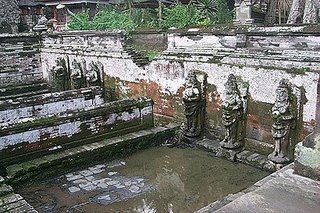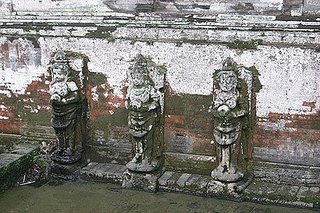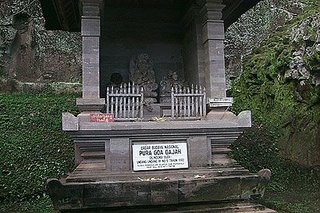

The cave below is reached by climbing down a series of steps. Two traditional bathing pools are decorated by life-size stone carved maidens bearing jugs of sprouting water. The clear cool water here flows from an underground well that is believed to possess magical properties.



The name of the cave is allegedly derived from the name Lwa Gajah (elephant waters) that was inscribed on a series of ancient palm leaf scripts by Mpu Prapanca, a great man of Sanskrit literature in 1365. Lwa Gajah is also the original name of the Petanu River, which flows close to this cultural destination. It is possibly due to this link that the local Balinese found it easier to refer to the area as Goa Gajah or the elephant cave.
The cave itself is decorated with stone relief work showing a demonic face with an open fanged mouth that reveals the entrance. Some scholars say that theoretically the carvings also depict images from the great Hindu epic Mahabarata, which teaches ethics and morality. Inside the cave there are several crevices that are thought to have been secret meditation chambers for either priests or hermits. The cave is actually not that large and forms a T-shape with a statue of Ganesha, a Hindu God of knowledge and wisdom. Lord Ganesha is characterized as an entity with an elephant head and four arms.
According to some old writings that can be found on the eastern wall of the cave’s entrance, this historical site was constructed sometime during the 11th century. A number of artifacts scattered around the cave have been analyzed by experts and support this time frame. Some of the relics such as the lingga (symbols of fertility) and the stone maidens located at the bathing pools have been directly influenced by Hinduism. However, there are also a number of Buddhist elements at the site including a statue of the deity Hariti, the protector of children.

 Goa Gajah is located in the western edge of Bedulu village and is just 6-km out of central Ubud. A visit to this ancient site that shows a distinct mix of classical Hindu and Buddhist facets makes a unique stop on any sightseeing itinerary for those who are interested.
Goa Gajah is located in the western edge of Bedulu village and is just 6-km out of central Ubud. A visit to this ancient site that shows a distinct mix of classical Hindu and Buddhist facets makes a unique stop on any sightseeing itinerary for those who are interested. 


Tidak ada komentar:
Posting Komentar